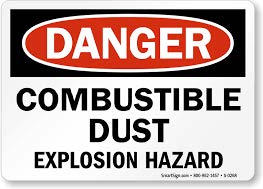It's a highly searched set of words on the internet: "OSHA Combustible Dust Standard..." But, it doesn't make sense. It should say "National Fire Protection Association (NFPA) Combustible Dust Standard". Essentially, the General Duty Clause (Section 5(a)(1) of the Occupational Safety and Health Act (OSHA) of 1970, employers are required to provide their employees with a place of employment that "is free from recognizable hazards that are causing or likely to cause death or serious harm to employees.') is being followed with OSHA, but building code requires you to follow NFPA. The ever changing science is too much for OSHA to keep up with so makes sense that NEP and NFPA guide the way...
In January of 2016, Bloomberg BNA published: "OSHA Poised to Pass on Combustible Dust in 2016". Not much has moved since then nor appears to be able to move. Rightfully so. As a regulatory agency, OSHA's abilities from a practical standpoint can sometimes be decades behind the boots on the ground. A one-size-fits-all approach for codes or tests not only does not apply to the variety of small businesses, evolving materials and equipment but even bigger facilities may need years to adapt and adopt.
NFPA develops and publishes more than 300 consensus codes and standards intended to eliminate death, injury, property and economic loss due to fire. It provides the following three codes directly addressing combustible dusts:
NFPA 652: Standard on the Fundamentals of Combustible Dust
So, while OSHA has guidelines, it cannot address nor keep up with the complexities "of the hazard and an already robust regulatory agenda, emergency response and industrial observers," per BBNA. Still, the "OSHA Hazard Communication Guidance for Combustible Dusts" is important for defining combustible dusts and the role of oversight in the workplace overall. OSHA'S National Emphasis Program (NEP) lays out the role of inspection and allowable levels of dust accumulation prior to testing - based on 1/32" and bulk, for example here: https://www.osha.gov/dep/enforcement/Combustible_Dusts_04212015.html
For more information on Combustible Dust Hazards Assessments (DHA), How to Collect a Hazardous Dust Sample or even Authorities Having Jurisdiction (AHJs), contact Dr. Ashok Ghose Dastidar, PhD, MBA, Vice President, Dust & Flammability Testing and Consulting Services, dastidar@fauske.com
